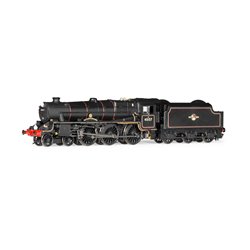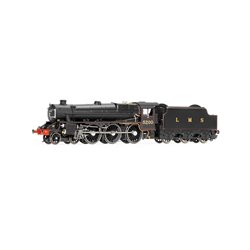Understanding the names that manufacturers give specific collections within their range can be a little bewildering...
No products
Product successfully added to your shopping cart
There are 0 items in your cart. There is 1 item in your cart.
Search Tips
Christmas and New Year
We are dispatching orders every weekday apart from Christmas Day, Boxing Day and New Year's Day.
If you select next day delivery at checkout, please note deliveries are not made on public holidays or Sundays.
The shop in Sandown is open 23rd and 24th December, then closed from 25th December, reopening on 30th December.
What is a Black 5 locomotive?
The Black 5 locomotive, officially known as the LMS Class 5MT, is one of the most iconic steam engines in British railway history. Designed by Sir William Stanier for the London, Midland and Scottish Railway (LMS), it first appeared in 1934 and remained in production until 1951, with 842 examples built in total. The "5" in its classification refers to its power rating, while "MT" stands for mixed traffic, reflecting its ability to haul both passenger and freight trains. These versatile locomotives could be seen all over Britain, from the Highlands of Scotland to the busy mainlines of the Midlands and beyond.
One of the key reasons for the popularity of the Black 5s was their robust and adaptable design. Stanier was tasked with modernising the LMS fleet and borrowed heavily from his previous work at the Great Western Railway. The Black 5 combined the power needed for heavy freight duties with the speed and efficiency required for passenger services, making it a workhorse capable of handling a wide variety of tasks. It could reach speeds of up to 85 mph and haul significant loads over long distances, making it a practical choice for railway companies during a time when steam was still the dominant form of traction.
The Black 5 was also known for its mechanical reliability and ease of maintenance. Unlike some earlier locomotives that were more specialised or had overly complex designs, the Class 5MT was straightforward, ensuring it could be maintained efficiently even in smaller depots. This contributed to its widespread use and long service life. Many of these engines were still in operation during the final years of British steam in the 1960s, and they became a familiar sight to both railway workers and the public.
In terms of design, the Black 5 locomotives were fitted with a 4-6-0 wheel configuration, which gave them stability at high speeds while ensuring good tractive effort for heavy loads. They were initially built with right-hand drive, though a number were later converted to left-hand drive for better driver visibility on certain routes. Throughout their production run, various modifications were made to improve their performance, including changes to their valve gear, tenders, and boilers, but the essential design remained consistent, underscoring its fundamental success.
For railway enthusiasts and modellers, the Black 5 holds a special place due to its widespread use and distinctive look. With its classic black livery, the locomotive exudes the essence of British steam power. The simple, functional design was neither overly ornate nor stripped down, making it a balanced and aesthetically pleasing engine. Many Black 5s survived into preservation, and several are still operational today, thrilling modern audiences on heritage railways across the UK.
In the world of scale modelling, the Black 5 is a particularly favoured subject due to its versatility and historical significance. Model railway enthusiasts, especially those focused on the steam era, often include the Black 5 in their collections. Available in popular scales such as OO and N gauge, these models typically feature highly detailed designs, with some even incorporating digital sound functions to recreate the authentic chuff of the steam engine. Whether placed on a passenger express service or pulling a line of goods wagons, the Black 5 adds a touch of realism and history to any model railway layout.
Modellers are also drawn to the Black 5 because of the various liveries and weathering effects that can be applied. During its working life, the Black 5 would have been seen in varying conditions, from a gleaming freshly cleaned locomotive to one heavily weathered after weeks of hard labour. Many manufacturers now produce weathered versions, allowing modellers to capture the engine as it might have looked in different eras of service. This flexibility adds to the locomotive's appeal for those recreating specific historical periods on their layouts.
The Black 5's enduring legacy is a testament to its successful design and importance in British railway history. Whether for its technical achievements, its role in the steam age, or its current place in preservation and scale modelling, the LMS Class 5MT remains a symbol of Britain's golden age of steam.
Click here to receive the tips weekly in your mailbox. You can unsubscribe at any time.









